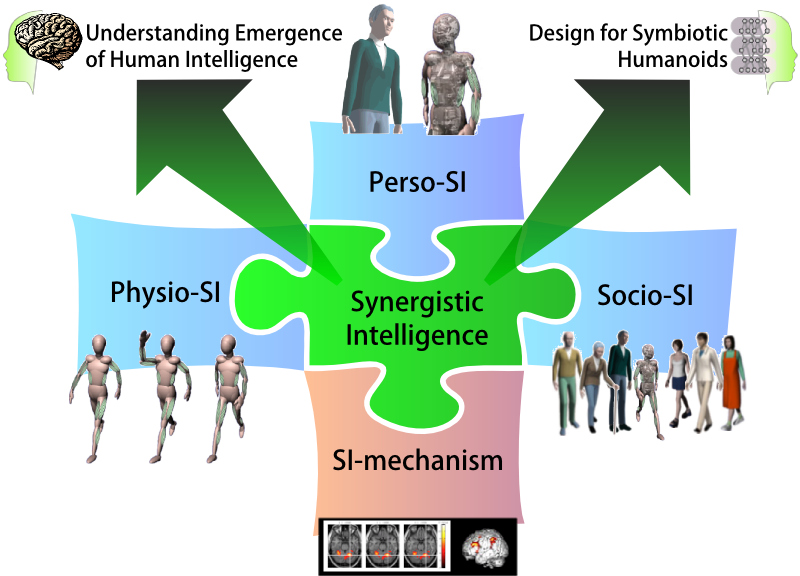Objective
The 21st century is known as the “Century of the Brain” and will be an era of robot habitation with humans. Currently, these notions are not related to one another, despite the related subjects of understanding and realizing the emergence of human intelligence. With advanced technologies, such as noninvasive imaging devices, recent advances in neuroscience are now approaching problems regarding cognition and consciousness, which have not yet been dealt with in science. However, current means are not sufficient to proceed with research regarding communication and language acquisition based on “embodiment” that epitomize the abilities of cognition and development. It is important for life sciences in the 21st century to regard the brain as a complete system, and to clarify how brains realize function through interactions with the external world based on its dynamics.
Humanoids are a class of human-type robot, and Japan is a world leader in this field. Despite rapid technological development, only superficial functions have been realized and there is no established design methodology for the emergence of human intelligence based on embodiment. It is indispensable to merge the science and technology through design, implementation, and operation of artifacts (robots) after clarifying the background deep-layer structures for the emergence of intelligence based on not simply the engineering to realize superficial functions but also the collaboration with the science fields, such as neuroscience and cognitive sciences. If these fields are merged organically, a means of verification utilizing robot technologies can be expected to promote a new brain science unique to Japan. We may also synthetically tackle the subjects of consciousness and mind, which used to be difficult to understand with conventional philosophy, psychology, sociology, cognitive science, linguistics and anthropology. Designing artifacts capable of passing these verifications necessitates innovations in current materials, such as robot sensors and actuators, and conventional artificial intelligence and control technologies.
Based on this basic concept, this study derives the design of intelligence lacking in current humanoid studies from interactions with a dynamic environment, including humans (interactions between environment and robot or between human and robot). In other words, we realize a new understanding and construction of human intelligence from a complex of science and technology through the design, implementation, and operation of humanoids, and by verifying the constructive model using the methods of cognitive and brain sciences. The new domain based on this complex is designated “synergistic intelligence.” This name refers to both the co-creation of intelligence by science and technology, and the co-creation of intelligence through the interactions between the body and environments. This new domain has four aspects. The generation of dynamic motions by artificial muscles allows co-creation of the intelligence though the interaction between the body and the environment and is called “ Physically synergistic intelligence (Physio-SI). ” The emergence of somatosensory and motion in fetal models allows co-creation in the uterine environment. In the process of developing cognition from various interactions with the fosterer, the fosterer is the most important environmental factor. Therefore, the synthetic model of the process is called “ Interpersonally synergistic intelligence (Perso-SI). ” In the emergence of communication between many humans and robots, the effect of the multi-agent environment is important and “ Socially synergistic intelligence (Socio-SI) ” serves as the core. “ Synergistic intelligence mechanism (SI-Mechanism) ” verifies these processes by comparing autism and William’s syndrome, which highlight extereme aspects of language and cognition capabilities, and promote the construction of a new constructive model. We will promote harmonious study within the group, and design strategies to realize a synergistic intelligence system in humanoids that require close linkage between groups.
The idea of “synergistic intelligence” promoted in this study is expected to help people recognize the importance of a constructive model and introduce more macroscopic views into the conventional studies of brain science and physiology, which tend to be microscopic for further development in various fields related to the brain. In addition, the idea is expected to lead to understanding by humans conducting high-grade social activities, and to the solutions of various problems regarding the psychological development and education of children.

